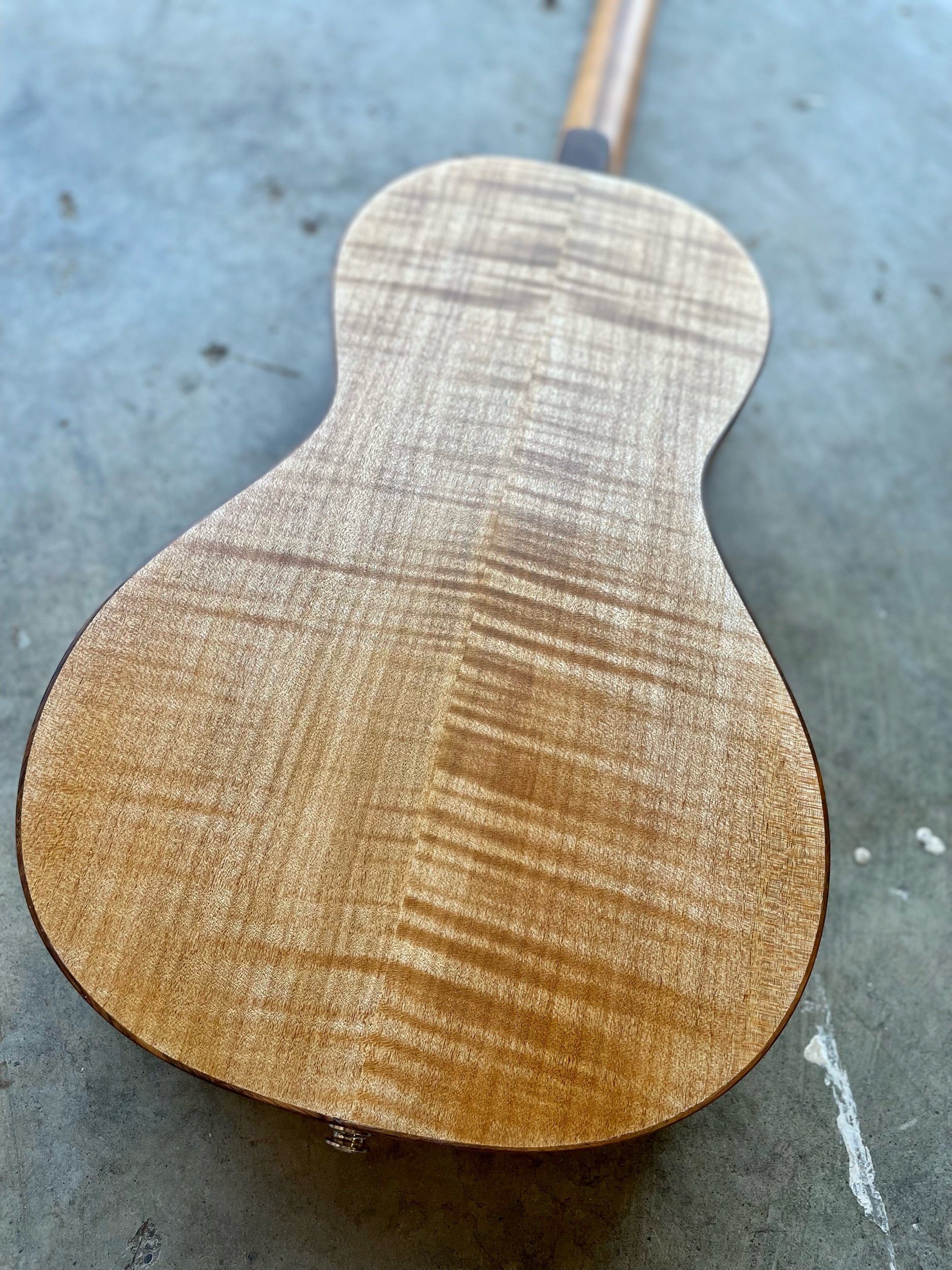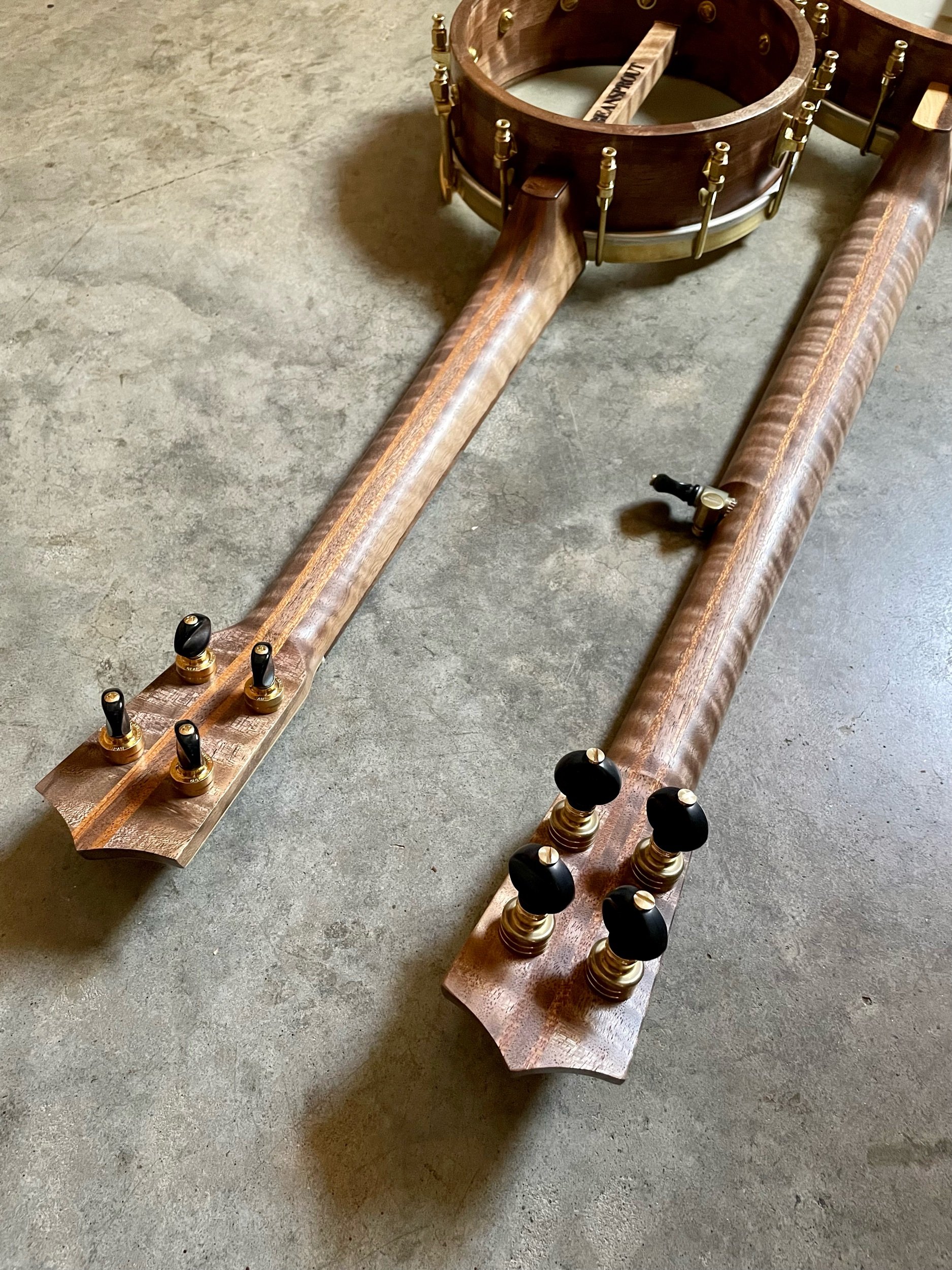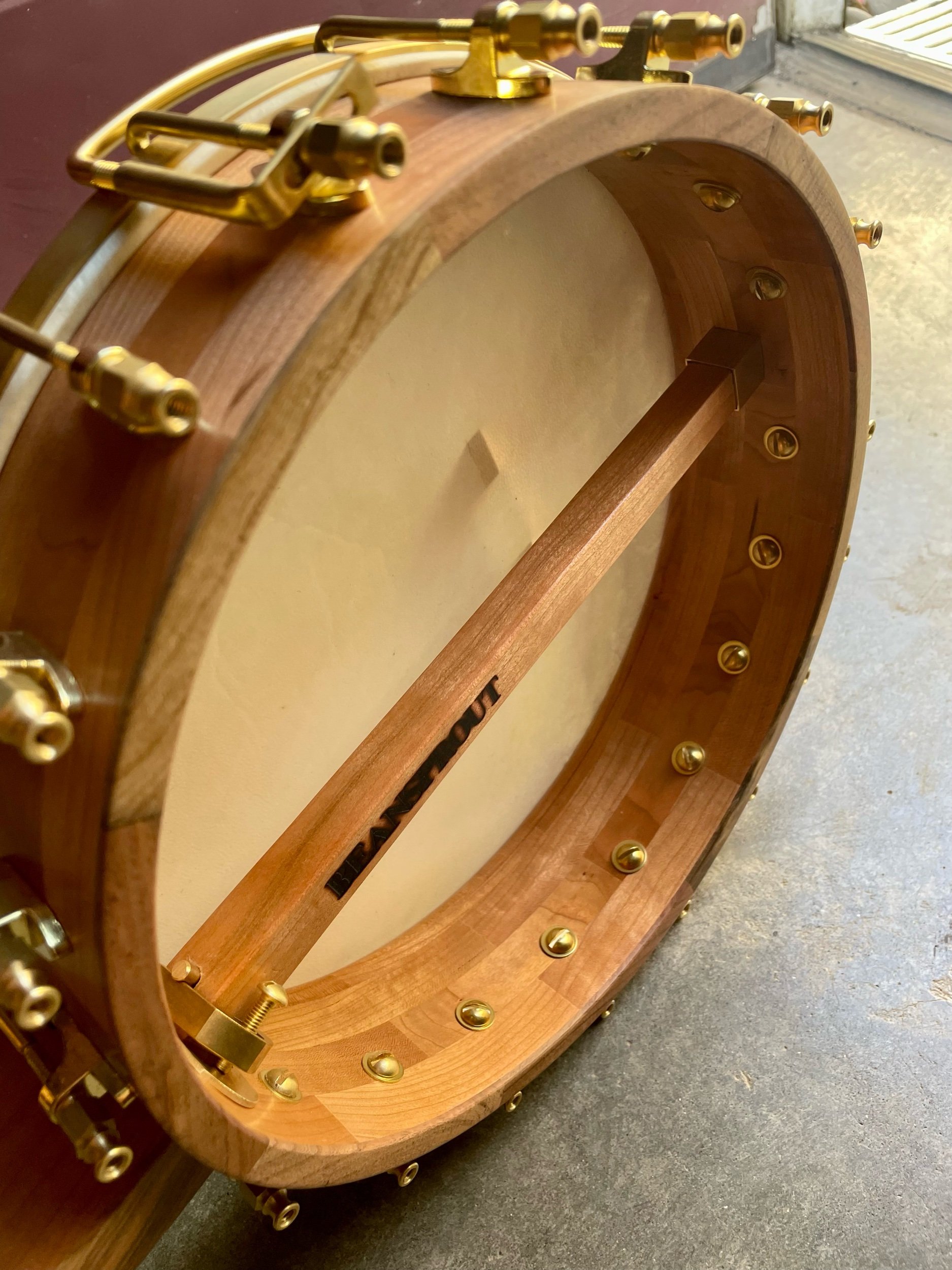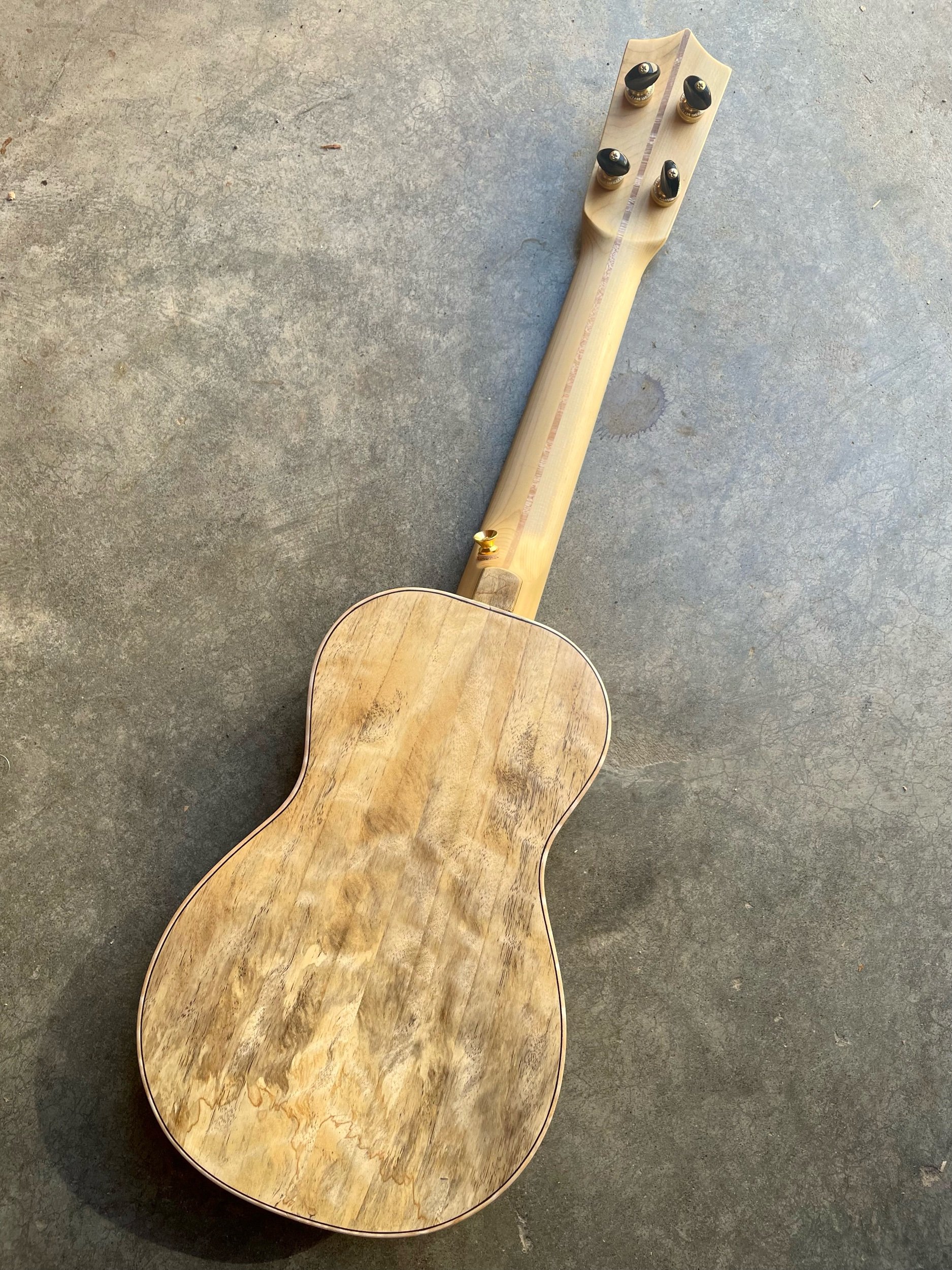Crisp and sweet, loud and full, easy to play and completely unique. I love this tenor. The one piece Spruce top is from a drift log from British Columbia. The Myrtle is from the Carpenter Ant Stash in Portland. The Fir neck is a salvaged floor joist. The rest is Pistachio from California Orchards. I love instruments like this with a muted, earth tone color palette. The bird’s foot purfling looks like a brown line from far away, but up close reveals it’s tiny beauty. Low g, K&K pickup, geared tuners, bone nut and saddle and fluorocarbon strings.
#825- Spruce and Curly Maple Tenor Guitar
As I go further down the tenor guitar rabbit hole, I knew I would have to make one in this tuning, gdae. It’s an octave lower than a mandolin and lower then the original designer imagined. But, I knew I could sort out the bracing and the string gauges to make it work. My tenor guitar is based on an old Regal, with 21.5” scale, a floating bridge, tailpiece and steel strings. It’s a little bigger than a baritone uke. The curly Maple is from a violin maker, the Spruce is a drift log from British Columbia, the Mahogany was salvaged from a Tacoma boat shop and the Texas Ebony is from a retired banjo maker. I’m looking forward to making more of these!
“Hey guys, just wanted to let you know I received my tenor guitar yesterday after work and it is gorgeous! It sounds amazing in this tuning and it looks great, plays even better! Thank you so much for trying out something new!
- C. F. ”
#821- Walnut and Pistachio Five String Banjo
This banjo is a nice study of contrasts. First, we chose very simple, straight grain Walnut but added crazy grafted Pistachio to it. Second, we chose a big 12” rim, but made a custom short scale neck to it. It ended up lighter than my bigger banjos but still sits solidly in the lap. Despite the smaller neck, it still has a big, rich and haunting sound. The Walnut is from a retired furniture maker from Vashon Island and the Pistachio is from California Orchards.
“I picked up the banjo today and can confirm it arrived fully unharmed!!! It was honestly even more beautiful than I was expecting, and so smooth and comfortable to hold. I am enjoying getting familiar with it. I’m so glad I went with the non-steel strings too. The neck is very very comfortable and easy for me to play.
Thank you again,
- P.T. ”
#826- Port Orford Cedar and Curly Myrtle Tenor Ukulele
I’ve been struggling lately to describe to people what the tonal difference is between Western Red Cedar and Port Orford Cedar. Today, I figured out what makes sense to me: Red Cedar sounds red, like autumn colors and funny/sad memories. Port Orford Cedar sounds green, like springtime and wishing for summer vacation. Am I crazy? Don’t care, it makes sense to me. This one started with the awesome asymmetrical Myrtle back, giving me the color palette for the rest of the Uke. The Myrtle comes from a Portland tree that I milled. The Port Orford Cedar top comes from southern Oregon and the Pistachio fretboard/headplate/bridge come from California orchards, both via woodfromthewest.com. The simple Fir neck is salvaged from a floor joist. It just sounds green to me!
“Hi to Aaron and family. I wanted to let you know how much I’m enjoying my new uke (826). I received it Monday and have had three days with it.
No.1, it is without parallel for intonation, in my experience. I’m extremely picky about that. Also, this uke is the lightest tenor I’ve picked up, and it’s perfectly balanced.
...Thanks to all of you for your parts in all this.
- J. M. ”
#820- Figured Western Red Cedar and Curly Walnut Tenor Ukulele
I love building for a customer who is both a friend and an artist I admire. But, I have to admit it can create extra pressure and anxiety as well. It all combines to create an interesting emotional texture for the build process. It’s all just…deeper. But that’s what we want from art, something deeper. So I’ll let this one go to Avery Hill and see what magic she creates with it.
The top is some figured Cedar salvaged from a water tank on Vashon Island. It was cut well over 100 years ago and will now begin its third life as an ukulele. The neck is Fir salvaged from a floor joist. The rest is Walnut that I milled from a stump at Zena Forest Products in Salem. Cedar and Walnut are a standard combo for us. It has a loud, deep and rich sound with a breathy attack.
#819- Curly Myrtle Soprano Ukulele
Even after all this time, I still consider the Soprano to be one of the most challenging designs. It has to sound full and rich but retain the volume and charm of the old instruments. Myrtle is one of my favorite woods for this, because when I get it right it sounds familiar but unlike a Mahogany Martin or a Koa Kamaka. This Myrtle is from the Oregon coast via woodfromthewest.com. The neck is Spanish Cedar and the rest is Texas Ebony, both woods were salvaged from a builder’s estate. I chose a headstock shape from an 1890’s Santo instrument. It has a flat fretboard, bone nut/saddle, fluorocarbon strings, an endpin, a strap button and dots at 5/7/10 frets. It comes with a hard shell case. The cost is $1650 plus shipping.
“Hi, Aaron and Nicole.
The myrtle, Spanish cedar, and Texas ebony soprano showed up as scheduled today. It is a beautiful, light, and easy to play instrument. The curly myrtle tonewood shimmers in the light. The bound Texas ebony fretboard and Spanish cedar neck balance the body perfectly. It’s clear that you put a lot of craftsman sweat into the details on this instrument. I really like the historical reference in the Santo headstock that truly fits the soprano tradition. The endgraft is a finely detailed grace note to the whole! As someone who doesn’t waste wood, I really appreciate the beauty marks left by the branch nodes in the headplate.
Your Youtube comment on getting it all right is right on! The sound is warm, sweet, and clear when played softly and stays that way when you dig in. It plays very loud without distortion. The sustain is the longest of any soprano that I have ever played. My wife was astonished that such a light instrument gave such a rich sound!
Many thanks for your work on this soprano. It will be a delight to play this one for years to come.
Best regards,
- D. H. ”
#814- Hemlock and Maple Scout Ukulele
I’ve been so busy and also trying to rest, that I haven’t gotten a Scout out to the waiting list in a few months. We’ll, here you go. This one sounds cheerful and confident, I really like it. Hemlock top, maple back/sides, fir neck, oak binding and walnut fretboard/headplate/bridge. All shop scraps saved from the burn pile, ready to make music.
#817- Maple and Pistachio Five String Banjo
Maple! Classic banjo tone, solid feel in the lap, big volume, rich and sweet tone. I contrasted the Maple with some Pistachio from California Orchards. 12” rim, brass tone ring, goat skin head and a comfortable arm rest. All the maple is from the Carpenter Ant Stash in Portland.
#812 and #813- Curly Walnut and Texas Ebony Banjo Uke and Five String Banjo
A matching pair for a pair of brothers, what a fun project! The bodies are curly Walnut from Southern Oregon, from woodfromthewest.com. Everything else is Texas Ebony from a retired banjo builder. The uke is tenor scale with a Renaissance head and a comfortable arm rest. The banjo has a 12” rim, brass tone ring, Renaissance head and arm rest. I love how they sound together!
#816- Curly Cherry and Texas Ebony Five String Banjo
Cherry and Texas Ebony has been a popular choice lately and it’s obvious why: it looks, feels and sounds great! This one has a 12” rim, non steel strings, goat skin head and a brass tone ring. All the wood for this one comes from a retired banjo builder. Nicole added a little wood burning on the dowel stick. Happy picking and Happy 30th Birthday Jason!
“Hi Aaron and Nicole,
I was ecstatic to receive a Beansprout Banjo as a 30th birthday gift from my wife! It’s a truly special instrument that looks, feels, and sounds great. I’m so grateful for the hard work and the passion you put into building this banjo for me.
Thank you,
- J. G.
”
#818- Cedar and Walnut Alto Ukulele
I love Cedar and Walnut for the rich tone and sustain, but it also has a percussive sound that I find really useful, especially in a smaller ukulele. This Walnut back and sides are from Goby Walnut in Portland and the Red Cedar top is from Chris at The Dee Mill. I chose a Yellow Cedar neck for a color contrast; this Cedar is from the beach at Camp Westwind. The rest is some dark and striped Pistachio from California Orchards. This beauty is headed out to our customer in Finland!
“The uke itself is incredible. I really have to commend the workmanship you put in your instruments. Everything about it is just sublime. I love the rather simple look of the uke with a little bit of elegance from the binding and quirky wood. But it’s really the tone that impresses me most. I’ve been lucky enough to play many excellent quality ukes and this really is right up there with the best. I’m always so impressed when such a small instrument can produce such a big sound. The tone is warm and resonant but still clear with great note separation, just how I like it. And on top of that the playability is sublime which I of course didn’t doubt for one bit. I couldn’t be happier.
I really want to thank you both, not only for providing a brilliant instrument but also making the whole process easy, fun and exciting from start to finish.
Cheers.
Best regards
-E.S. ”
#815- Maple and White Oak Scout Mini Banjo
This banjo follows my “Scout” line of ukuleles, meaning I get to pick the wood, it uses my thin steam bent rims, less metal hardware and a super thin beeswax and oil finish. This makes for a lightweight, vibrant, rustic and lower cost banjo. The Maple from this is leftover from a Colorado cabinet maker which I’ve saved for many years. The Oak is from two places: wine barrels from up the road and a tree from our friend Larry’s property. #815 is headed to Europe for a bicycle trip! Bon voyage!
“I just wanted to express my deepest appreciation for getting me little beansprout to me! I cannot even tell you how much I love it!!!! I adore and treasure this beauty and I can’t stop playing it.
I am so happy happy happy!
- Y. G. ”
#811- Spruce and Myrtle Tenor Ukulele
This is what I am here for: simple lines, natural wood patterns, careful construction, easy playability and big tone. It looks simple from far away but contains endless details. The Spruce is from luthier Craig Wilson, harvested from Vancouver Island. The Myrtle is from the Oregon coast and the Pistachio is from California Orchards, both via woodfromthewest.com. The Fir neck is salvaged from an old floor joist, with a filled nail hole to keep us humble. Happy strumming!
#809- Walnut and Maple Mini Five String Banjo
I use Walnut and Maple frequently, but I think this is the first time I have combined them in this way, mixing them in equal measure all over the instrument. The Walnut is quality straight grain stuff and the Maple is a mix of bird’s eye and curly, all from the Carpenter Ant stash in Portland. It is strung with the heavier strings to get open G tuning, it also sounds great tuned one step higher. The mix of woods made for a vibrant sound that is subtle and a little bit polite compared to my last few mini five strings. I really liked it once I got the chance to play it this week in the shop.
#805- Oak, Cherry and Pistachio Mini Five String Banjo
For banjos, I usually stick to two kinds of wood on a build, but lately some customer requests have pushed me to use three, which has turned out well. In this case, I used Red Oak for the main wood and added Cherry neck stripes, rim cap, heel cap and head plate. For the fretboard we chose a funky Pistachio fretboard that matched the color scheme and I like it. This one is strung low to A tuning and has an arm rest for playability and comfort. It’s got the dusty, rich sound that I expect from Oak and nice volume. The Oak and Cherry are from the Carpenter Ant stash in Portland and the Pistachio is from California orchards.
“I want to thank you for creating such a magnificent instrument. The case is perfect, I don’t know if you had this made for you or it is an off-the-shelf model made for tenor banjo ukuleles but it fits the mini-banjo perfectly. The fretboard is even more beautiful in person than in the photos, and the scoop is so practical. Oak has always been my favorite wood and I am so happy to find a luthier who uses it for banjos. I don’t understand why it is not more commonly used. I almost ordered one of these mini-banjos a few years back but fate stayed my hand and by waiting I was able to get my favorite wood. You are right to describe the sound as dusty. The biggest surprise is the strings. In the past I have had zero luck with non-steel strings but these do the job beyond expectation - the sound and the feel are just what I wanted. I tuned it down to G and it is fine in that tuning. I admit to having some concerns about the scale length being a tad too small but such is not the case. This is very comfortable to play and does not present the problems my full scale banjo does. All in all a well-made work of art that is also a very enjoyable musical instrument. Thank you.
- D. B. ”
#808- Bearclaw Spruce and Curly Koa Tenor Ukulele
Nice. I tried to make it fancy, but it still looks calm and peaceful to me. When I strum it, the sound just explodes! The top is salvaged Bearclaw Spruce from Alaska. The back, sides and fretboard are Curly Koa from Bart’s sawmill on Oahu. The neck is made from Mahogany and Maple scraps from the Carpenter Ant stash in Portland. It is bound in Walnut with Maple purfling. The headplate, pickguard, end graft and heel cap are a scrap wood mosaic of Walnut, Koa and Maple. It has a K&K pickup, low g, bone nut and saddle, geared tuners and radiused fretboard. As with all of our Koa instruments, we will donate a portion of this sale to Saving Hawaii’s Forests.
“Hi, I decided I would take my time before I got back to you on #808. After having played it for months now, I can say that I believe that this is the finest instrument that I own.
It was love at first sight when I saw it in your newsletter and 808’s beautiful sound came through even in the YouTube demo. It sounds incredible in person - loud, clear, and perfectly intonated. I can feel it vibrating with a life of its own when I strum it. I am so, so happy with this ukulele.
Thank you for this beautiful instrument!
- C.H. ”
#802- Cherry and Pistachio Five String Banjo
Cherry seems to have overtaken Walnut in the last year as the wood of choice for banjos with our customers. It’s generally not as loud as maple, but it’s plenty bright and vibrant. It’s not as mellow as Walnut, but has a rich darkness that I like. I made the 11” rim out of cherry blocks and a pistachio decorative layer. The neck is a five piece neck built up of curly cherry and walnut. Pistachio fretboard and headplate add some color to the front. This one has no tone ring, a goat skin head and non steel strings. It feels and sounds great! The cherry from this comes from the Carpenter ant stash in Portland, the Pistachio from California orchards.
#807- Yellow Cedar and Tamarind Alto Ukulele
Once or twice a year a customer asks me to build using their wood. For many reasons, I usually say no, but for this project I said yes. This is a special gift from our customer to his 84 year old father who lives in Puerto Rico. His father had a Tamarind tree in his backyard while growing up and he holds special memories of playing around the tree and eating its fruit. Tamarind is a food crop tree that has spread all around the world in tropical climates. It is often harvested off the forest floor, which allows fungus to grow, making the spalted colors you see. Since I already use a lot of sustainable orchard trees, this seemed to fit my values. I chose a Yellow Cedar top and neck that we harvested off the beach at Camp Westwind in Oregon. It drifted down from Canada and also is spalted. For the fretboard, I thought I should choose another wood that evokes travel and migration, so I made the fretboard from Teak! Teak is an expensive hardwood from Asia that is prized by boat builders. I would never buy it normally, but I found some when cleaning out a corner of the Carpenter Ant stash in Portland. It is dense, stiff and naturally oily. Perfect for fretboards. I’m fact, after my Texas Ebony runs out, this will likely be my dark brown fretboard wood, so stay tuned. Overall I am really pleased with the aesthetics, the sound and the spirit of this uke. I’m honored to be a part of a project like this!
(BTW I accidentally said “bridge” when I meant to say “fretboard” when discussing the Teak on the video. Oops!)
#810- Maple and Oak Concert Banjo Uke
The heart of this project is a steam bent rim from an oak tree from our friend Larry’s property. I usually use a block rim or segmented turning for my rims, but steam bending green wood has been a fun and educational experience this year. The neck and rim cap are maple, while the rest is made of various Oak scraps laying around. I added a pickup and quick and natural oil/wax finish. I’m ready for my gig tonight!
#806- Spruce and Curly Walnut Baritone Ukulele
A baritone should be light and vibrant, but also dependable and solid. It’s a fine line, but I love chasing that balance. This uke has an Englemann Spruce top with some rare color variations. The curly Walnut from Southern Oregon is so beautiful for back sides and some some binding. I have more of it, from Kevin at woodfromthewest.com. The green striped Pistachio for fretboard, headplate and bridge is from California orchards, also via Kevin. The customer added some subtle class with a rope rosette and end graft.
“As I looked for your email today to finally thank you, I noticed that it’s been exactly a year since I placed my order. From then until now, it’s been a great experience. The anticipation of the build, the updates on the process and finally receiving this beauty was second only to the last few of months of playing around with her. What a looker. Great voice. Lovely backside. Pretty face. She’s easy on the eyes for sure. She’s articulate and clear about what she has to say. Of course, she lets me know when I step out of line, though she’s kind and forgiving. She feels smooth and light in my hands and smells wonderful as she lays on my chest. Love her creamy smooth neck and curvy bottom. She’s elegant with a subtle classy way about her. Photos don’t due her justice. At first, I hid this relationship from my wife. I knew she would be jealous, but this sweet thing won her over with her charming personality and lovely songs. I know it’s not just summer love. I’m confident this relationship will last a long time.
- S. C. ”














































































































































